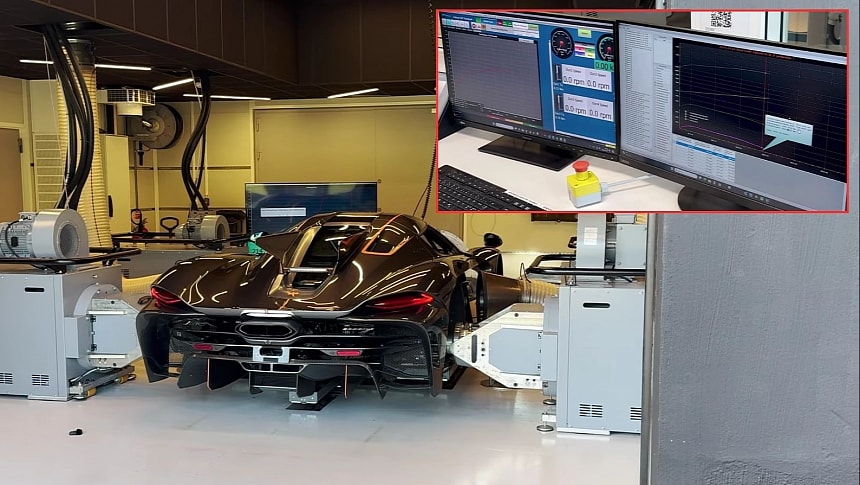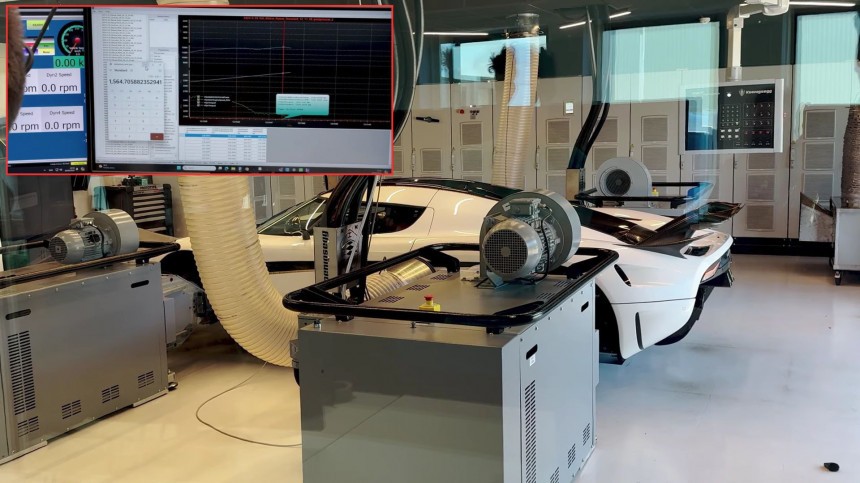You might have seen motoring publications quote 1,600 horsepower for the Jesko, but said ponies are metric because Koenigsegg is headquartered in a country that adopted the metric system in 1878. Even the Wikipedia entry for the Jesko got it wrong, listing the V8-powered bruiser with 1,622 pferdestarke on corn brew instead of 1,600. The advertised 1,600 cavalli vapore convert to 1,578 horsepower, but how many of those ponies reach the wheels?
Enter Steve Hamilton, a.k.a. The Hamilton Collection on social media, and a bald guy who is curiously named Christian von Koenigsegg. Jokes aside, Steve paid a visit to the Koenigsegg factory, where Christian showed him – among other cool things – his personal Mazda MX-5 Miata and a previously flooded Regera that had been rebuilt. Christian owns the NA-gen roadster since he was 19 years old, while Regera chassis number 7235 was flooded by Hurricane Ian back in September 2022 in the owner's garage.
Right, dyno testing! On the hub dyno, the Jesko made 1,374 ps (1,355 hp) on the hubs. Accounting for drivetrain losses, that would be 1,616 ps (1,594 hp) at the crankshaft, which is more than Koenigsegg's estimate. For some reason or another, Steve didn't share the results for the second run. In any case, it's worth noting that Jesko can also take premium gas, in which case its 5.0L twin-turbo V8 cranks out 1,280 chevaux or just around 1,262 stallions.
The flat-plane crankshaft V8 spins to 8,500 revolutions per minute, with max torque coming in strong at 5,100 revolutions per minute. Koenigsegg says 1,500 Nm (1,106 pound-feet) tops, while 1,000 Nm (738 pound-feet) are developed from 2,700 through 6,170 rpm.
Given this engine, the so-called Light Speed Transmission with nine forward gears, the curb weight of 1,390 kilograms (3,064 pounds), and the low-downforce specification dubbed Absolut, are you surprised that Jesko holds the record for the fastest production car from zero to 400 kilometers per hour (249 mph) and back to zero? Devoid of active aero trickery, the 0.278-Cd hypercar did exactly that in 27.83 seconds.
Factory test driver Markus Lundh topped 413 kilometers per hour (256 mph) in just around a mile on the Orebro Airport's sole runway. Christian is gunning for the record that matters most in this particular automotive segment, that being maximum speed. The founder targets 330 to 350 miles per hour (531 to 563 kilometers per hour), but only time will tell if the Jesko Absolut will better the 305-mph Bugatti Chiron Super Sport 300+. Before that, Koenigsegg has a bit more testing, development, and approval to do.
Steve's video further includes two dyno tests with a Regera, namely a different Regera from the rebuilt one. A plug-in hybrid with twin-turbo V8 muscle and a direct-drive setup instead of a multi-gear transmission, Regera premiered nine years ago at the 2015 Geneva Motor Show. It packs three electric motors from Mercedes-controlled YASA, which also supplies the electric drive units of the Ferrari SF90 and 296.
Numbers? Glad you’ve asked! Over 1,500 ps (1,479 hp) combined, with 1,500 ps also serving as the rating for the internal combustion engine alone on E85, with maximum torque rated at over 2,000 Nm (1,475 pound-feet). Curb weight is estimated at 1,590 kilograms (3,505 pounds), which is not really unusual for a plug-in hybrid with carbon-fiber everything.
First time hitting the hub dyno, it made 1,548 ps (1,527 hp) at the crank. As for the second run, the dyno recorded 1,564 ps (1,543 hp). Can we agree that Koenigsegg is sandbagging? Then again, BMW is also known to be rather conservative with its crankshaft ratings for six- and eight-cylinder mills.
Right, dyno testing! On the hub dyno, the Jesko made 1,374 ps (1,355 hp) on the hubs. Accounting for drivetrain losses, that would be 1,616 ps (1,594 hp) at the crankshaft, which is more than Koenigsegg's estimate. For some reason or another, Steve didn't share the results for the second run. In any case, it's worth noting that Jesko can also take premium gas, in which case its 5.0L twin-turbo V8 cranks out 1,280 chevaux or just around 1,262 stallions.
The flat-plane crankshaft V8 spins to 8,500 revolutions per minute, with max torque coming in strong at 5,100 revolutions per minute. Koenigsegg says 1,500 Nm (1,106 pound-feet) tops, while 1,000 Nm (738 pound-feet) are developed from 2,700 through 6,170 rpm.
Given this engine, the so-called Light Speed Transmission with nine forward gears, the curb weight of 1,390 kilograms (3,064 pounds), and the low-downforce specification dubbed Absolut, are you surprised that Jesko holds the record for the fastest production car from zero to 400 kilometers per hour (249 mph) and back to zero? Devoid of active aero trickery, the 0.278-Cd hypercar did exactly that in 27.83 seconds.
Steve's video further includes two dyno tests with a Regera, namely a different Regera from the rebuilt one. A plug-in hybrid with twin-turbo V8 muscle and a direct-drive setup instead of a multi-gear transmission, Regera premiered nine years ago at the 2015 Geneva Motor Show. It packs three electric motors from Mercedes-controlled YASA, which also supplies the electric drive units of the Ferrari SF90 and 296.
Numbers? Glad you’ve asked! Over 1,500 ps (1,479 hp) combined, with 1,500 ps also serving as the rating for the internal combustion engine alone on E85, with maximum torque rated at over 2,000 Nm (1,475 pound-feet). Curb weight is estimated at 1,590 kilograms (3,505 pounds), which is not really unusual for a plug-in hybrid with carbon-fiber everything.
First time hitting the hub dyno, it made 1,548 ps (1,527 hp) at the crank. As for the second run, the dyno recorded 1,564 ps (1,543 hp). Can we agree that Koenigsegg is sandbagging? Then again, BMW is also known to be rather conservative with its crankshaft ratings for six- and eight-cylinder mills.


























